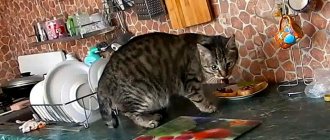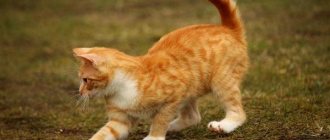Cats 74508
Childbirth is quite stressful for cats, as it is for absolutely any woman giving birth. Often, cat psychology, already poorly understood by people, changes significantly after the birth of offspring. You can often observe how a pet bites its babies, hits them with its hind legs or drags them by the scruff of the neck, while the kittens squeak.
The owners, alarmed by this behavior of their pet, begin to sound the alarm. However, not every mother cat nibbling on her litter is a danger signal. In this article we will try to understand when the behavior of a new mother is within the normal range, and when it is worth worrying about.
Kitten bites by mother: parenting methods or a warning sign about problems?
Carefully observing the relationship between a cat and kittens, owners often notice that the pet does not show very warm and tender feelings towards its cubs. The reasons why a cat bites its kittens usually lie in ancient natural instincts, but sometimes they are also caused by external factors.
Biting as a method of education
Nature has not given a cat much time to feed and raise its offspring. As a rule, after 2 - 3 months the female is again ready for fertilization and gestation. Therefore, in a short period of time, the mother must raise and teach her cubs the laws of survival in harsh reality. At the same time, the learning process involves not only biting the baby; those who are especially slow-witted can get hit with a paw. The cat is trying to instill in the young the rules of good manners, how it is possible and how it should not behave in a given environment. At the time of upbringing, the mother can persistently, but without causing injury or leaving marks, bite the child until it understands what is required of it.
Taking care of her offspring, the mother closely monitors that all the kittens are in her field of vision, in the best case - in the nest. And if a particularly nimble and restless baby constantly tries to leave the house, tries to crawl away or run away, the cat applies appropriate educational measures to him, bites him and demands obedience.
Quite often, the mother herself accustoms her babies to the tray. And if the kitten does not understand what is required of him and refuses to go to the toilet in a specially designated place, the pet, as a rule, takes strict measures to raise the careless cub.
A mother cat may bite her kittens when she is tired, wants to rest, and naughty children are too annoying and disturb her.
What not to do in the process of education
In the process of weaning a cat from the habit of biting, it is important to avoid common mistakes:
- You can't hit a cat. You can scold her in a stern voice and leave her alone for a while. The cat will understand that biting its owner's hand or leg is unacceptable. And physical violence will embitter the animal even more.
- Prohibitions must be observed by all family members. If the owner is trying to wean the animal from biting, and the others allow the pet to behave this way, you should not expect success.
- You cannot deliberately provoke a cat. Don't tease her on purpose. After all, if you punish her after that, she will be completely confused.
You can’t deliberately give a cat fingers to bite, otherwise you’ll never wean it off.
- Do not play with your cat without special equipment. You can use toys that exclude direct contact: laser pointers, wind-up mice, bows on strings. You cannot use your own hands and feet. Otherwise she will get used to biting.
- You cannot limit your pet's movement. In order to develop properly, a cat must run, jump, and imitate hunting. The lack of such an opportunity and being forced to stay within four walls cause behavioral anomalies.
Playful attitude
One of the main reasons why a cat bites their feet is boredom. The owner should not forget to diversify the animal’s environment, give it a toy, play together and carefully hide objects that it is not desirable for the pet to become an object of interest to.
A cat may have dozens of toys, but too many can become boring. Therefore, you should hide some of them, and display only part of them, and after a while change their places. In this case, the cat will treat the previously hidden toys as a completely new object and will again show interest in the object.
When a cat jumps up to bite, the owner can throw him special toys, previously frozen in the refrigerator, or ice cubes. Biting such cold materials will calm the cat.
Attention! This method is especially applicable for small kittens whose teeth itch. After all, by biting the owner’s legs, they try to soothe pain in the game
Leg biting is a way to attract the owner's attention when the cat wants to play. You should pay more attention to your pet, play with it more often, then the problem will be solved.
A playful attitude is a popular reason for biting the owner's feet.
Why does an adult cat not accept and offend a new kitten?
No cat wants to share “personal property” with a stranger. In this case, the age and gender of the latter do not matter: with equal probability, an adult animal and a small kitten, a “boy” and a “girl” will be attacked. Proving his dominance, the old-timer will not do any favors to anyone.
In the best case, an adult cat will react neutrally to the new tenant of the apartment and will only periodically hiss at him, warning him about violating personal boundaries. At worst, in any controversial situation the baby will be pawed, bitten and offended in every possible way. One way or another, you should not expect that an animal that has already taken root in the house will accept a new kitten right away. Such cases do occur, but they are rare. More often than not, making friends with pets requires a lot of time and effort on the part of their owner.
Cat psychology: why does a cat bite kittens?
Childbirth is quite stressful for cats, as it is for absolutely any woman giving birth. Often, cat psychology, already poorly understood by people, changes significantly after the birth of offspring. You can often observe how a pet bites its babies, hits them with its hind legs or drags them by the scruff of the neck, while the kittens squeak. The owners, alarmed by this behavior of their pet, begin to sound the alarm. However, not every mother cat nibbling on her litter is a danger signal. In this article we will try to understand when the behavior of a new mother is within the normal range, and when it is worth worrying about.
Other reasons for biting offspring
Sometimes in this way the mother can stimulate the motor activity of the young. Sometimes she takes out on him her dissatisfaction with living conditions: high temperature, cramped nest, noise around him. If you often touch kittens with your hands, then the mother may be irritated by foreign odors emanating from the children.
The onset of estrus is another reason for the mother’s aggressive attitude towards her cubs. Females instinctively feel that one of the children is not viable. By biting, they check the health status or try to get rid of such babies.
Why is a cat aggressive towards her kittens?
A cat can become aggressive towards her kittens if she feels threatened. When this happens, she may abandon them to spare herself. Examples of this could be another animal or cat threatening her, or a loud, unexplained sound that is startling.
Obviously there could be other reasons, but this is an example of how it could happen. So if it happens, you know why it might happen. In the next section, I will explain how you can prevent your cat from biting her kittens.
© shutterstock
Rejection of foreign odor
In the case where a cat bites its offspring, and at the same time was previously picked up on the street or has access there for walks, this is a very bad sign. The fact is that such animals always remain semi-wild and their natural instincts are more acute than those of fully domesticated pets. Here, the reason for aggression towards one’s own offspring can be a foreign smell on the kittens. Unlike people, who recognize others visually, animals are identified using smell. Do not touch the kittens while the mother cat is nursing them, otherwise she may abandon them completely.
A very pressing question!
When a baby arrives at a new home, he is between 7 and 14 weeks old. This is a golden time for the development of basic cat habits. Genetic programs turn on and begin to work actively - instincts that must be brought to perfection in games with his mother and littermates, but now both his mother and brothers are replaced by a new family.
Playing in the Animal Kingdom is entertainment only in the last resort. Its first and main role is education. Yes, yes, it is education, in all its diversity: the game educates, socializes, trains and develops the mental qualities of the younger generation. In no case should a kitten be deprived of the opportunity to develop his skills in games, but the owner has every right to set the rules and demand their implementation.
Now you understand why a kitten bites and scratches during play. It is very important for a baby to learn how to use his teeth-needles and claws-hooks correctly and at the right time:
- For games there is a certain time, place and mood of all participants. Forcing a game is punishable;
- No game will continue if at least one of the participants does not comply with the rules;
- A signal of pain or a threatening warning is always followed by physical punishment;
- Biting and scratching toys is allowed, but biting the owner’s hands and feet is taboo!
BY THE WAY! Sometimes a cat raised outside a human home will lunge, scratch and bite whenever a person tries to establish contact with it. This is a problem of missed socialization. This behavior cannot be corrected quickly.
Physical activity
Where else, if not in games, can teenagers build muscle mass, hone agility, strength and speed? Of course, you need space and the ability to run. If a kitten grows up in a city apartment, space issues may arise. Try using a few techniques to explain to your kitten that your room is a quiet den, not a playground:
- Methodically silently catch and remove the raging kitten from the room where he is not allowed to run;
- Transfer your sleepy pet to this room every time just as methodically;
- Each time, offer to move the game to a permitted place, where toys and improvised equipment for physical exercises have been prepared in advance;
- Do not reward (with words, third person language, laughter, glances, camera roll, touch or any other attention) any unwanted behavior, even if it is very funny;
- Try to get your kitten used to wearing a harness and going for walks and playing outside.
Something else interesting: Choosing a pet (cat): age and place of purchase
Claws
Everything related to claws has a direct bearing on hunting and territorial behavior. If the kitten does not learn in time to use this tool for its intended purpose (for example, to use a scratching post), the matured pet may experience some difficulties: marking territory, competitive and territorial aggression, self-esteem problems and demonstrative behavior.
Teeth
Inexperienced owners often panic: my very small cat bites, what should I do? The answer is obvious - educate. And education is, first of all, an explanation of the rules, an understanding of behavior and fair punishment, and in that order.
IMPORTANT! You cannot punish for something that has not yet been explained! The algorithm must work: establishing a rule - warning about violation - punishment.
For example, if a kitten attacked his legs from a hiding place, then by spanking him, you will only transfer his actions from the category of play to the category of conscious competition. And it is quite possible that next time the baby will intentionally cause pain and figure out how to escape punishment. Below we will reveal several secrets of raising young predators.
How to recognize conflict between pets? Will it lead to a fight?
Cats adapt well and share space with other pets even in the absence of any connection with them. Animals living in the same household may form cliques or splinter groups. In them, relatives coexist side by side, but each remains “to his own opinion” and tries to avoid contact if possible. This does not mean that there will not be cases of open confrontation between members of isolated factions over access to certain resources at certain times. This suggests that instead of physical “fighting”, cats will prefer “psychological pressure” as a more effective tactic.
Within the cat group there are individuals who seek to suppress their relatives, and they need a victim. It becomes a pet, which reacts strongly and with pronounced fear to the threatening actions and posture of its cohabitants. The more afraid an animal is, the more willingly its relatives are involved in this “game”. Some representatives of the cat family do not stop until they kick the victim out of the house. Cats that are being bullied begin to get sick due to constant emotional stress. Therefore, it is very important to notice “quiet” cat conflicts in time. Signs that your pet has turned into a victim include staring in its direction, trying to take its place to sleep, obstructing attempts to climb onto your lap, jumping on it while resting, and blocking passages (for example, an aggressor animal may block the flap window in the door or the path to the tray with your body). Psychological bullying is not easy to spot. A tyrannical cat, lying between its fellow cat and some place attractive to cats, does not look aggressive. From the outside it may seem that the animal is simply choosing a location that is convenient for itself.
The cat chews everything, what should I do?
The cat bites and chews everything in the house. These could be pencils, laces, toys and other items.
To make your animal behave calmer, you should diversify its diet or purchase special vitamins at pet stores. During the period until the animal stops gnawing everything, it is better to remove all objects that could harm it from the animal’s eyes. When biting wires, your pet can receive an electric shock; when eating soft objects, particles can enter the stomach and remain there, causing obstruction.
How to stop a cat from chewing
Star balm will help you!
If there are a lot of objects in your house that your cat likes to chew on, and you have no way to hide them. In this case, the well-known “Star” balm will help. Use this balm to lightly lubricate objects that are in plain sight. The pungent smell of the Star will scare away the cat.
What to do, how to make friends with pets?
The following tricks will help you make friends with cats so that they get along calmly in the same territory:
- Separation of territory and property and isolation. At first, it is better to keep animals separately, in different rooms. If you periodically change cats' places, they will quickly get used to each other's smell. At the same time, you should not allow the new pet to use the “master’s” bowls and tray. This is how an older cat may feel a threat to its dominant position.
- Equal conditions. The arrival of a new tenant in the house should not lead to the first cat receiving less affection and attention than before. The owner should try to devote the same amount of time to the animals. At the same time, both pets should receive the same rewards and punishments for the same actions. You should not give your new ward any concessions or allow too much “while he is not yet used to it.” This will naturally cause jealousy in an old cat.
- Behavior correction. At first, you should not leave the animals alone. The owner will have to carefully monitor the pets’ attitude towards each other and, if conflicts arise, personally separate the pets, scaring them with loud bangs or spray water.
- Use of sedatives. Undesirable behavior in children can be corrected with the help of special medications. Such remedies as “Cat Bayun”, “Feliway” and “Stop-stress” will help reduce the level of aggression.
Depending on the circumstances, it can take anywhere from a few days to a year for the animals to get used to each other. What should you do if, even after this period, one cat hisses at the other, takes threatening poses and demonstrates hostility in every possible way? Unfortunately, if contact between pets has not occurred in 12 months, it will not appear in the future. In this case, the most humane solution would be to permanently resettle the animals by finding another home for one of them.
Source
Disease
There are times when a pet suddenly begins to show excessive aggression both towards its own babies and towards its owners. It is not uncommon for cats to develop eclampsia after giving birth, and this can be a reason for sudden hostility.
2:1619
Eclampsia is a disease that should only be diagnosed by a specialist. It is not recommended to make a diagnosis yourself, because the cause of aggressive behavior may be simple fatigue or pain in the mammary glands (mastopathy). And yet, given that this disease occurs quite often, let's talk about it in more detail.
2:648
3:1152
Calm down or protect from danger
The psychology of the cat family is radically different from that of humans, and yet, in some ways we are similar. These animals, just like people, have their own methods of raising and protecting babies from danger.
Where a human mother would slap a naughty fidget on the butt, a cat mother will in the same way tell her baby how not to behave by biting the scruff of the neck. She can punish the kitten if it gets too excited and runs around, ceasing to notice everything around it. And also if the baby, being in a playful mood, climbs up to her, and in the meantime she tries to take a nap and replenish her strength.
A cat is capable of biting the skin of kittens that are trying to get out of the nest if she thinks that it is too early for them to do this. She will definitely claw her by the scruff of the neck or even hiss threateningly, not letting her onto the balcony, which, in her opinion, can be dangerous for furry fidgets.
You don’t have to worry if you notice how the mother stands over the baby and then takes his scruff in her mouth, then lets go. There is a high probability that at this moment she is not trying to harm him, but, on the contrary, wants to move him to a safe place. She just can't do it for some reason. Probably, the pet cannot figure out how best to lift it so as not to harm it. This sometimes happens, however, after several attempts, as a rule, the cat copes with the task.
The Art of Hunting
Don’t let it come as a surprise to you when your pet begins to teach her offspring to hunt. At the beginning of classes it will look something like this: the mother cat firmly grabs the kitten with her front paws and beats on him with her hind paws. At the same time, she alternates between biting and licking him. In addition, it can purr loudly, encouraging it to learn.
At the initial stage of training in the art of hunting, the cat demonstrates with its kittens how to properly capture and subdue the prey. In addition, the ability to suppress will be needed by the young when they grow up and begin to defend their rights to territory and dominance. And believe me, in a couple of weeks you will already be watching kids practicing these techniques on each other.
When the litter grows a little more and begins to crawl out of the shelter, a slightly different picture will open before you. In addition to the training activities described above, demonstration hunting jumps and pursuit will be added. Mommy, by personal example, will show the children how to sneak, wait and suddenly jump on the victim. Everything will remain the same with the squeak: if you meow, you understand. As before, the young animals will continue to practice the techniques both among themselves and on the mother.
Natural hunting instincts
Fluffy pets are born hunters with a highly developed hunting instinct. The mother begins to teach the kittens the wisdom of hunting as soon as they grow up and get stronger. The cat bites its cubs, showing them how to grab and hold prey so that it does not escape.
Most often you can observe the following picture: the mother grabs the baby with her front paws, bites him on the neck and beats him with her hind legs. Thus, the animal demonstrates basic hunting techniques. After the kittens receive such a master class, they begin to hone their hunting skills on each other.
This process is also controlled by the cat. And as soon as, in her opinion, the kids start playing, she intervenes, gently biting them on the neck.
Self defense lessons
In the wild, a young animal faces various dangers. Therefore, the task of any mother is the need to teach her offspring to repel the enemy. And even though domesticated cats are no longer threatened by serious predators, nevertheless, at the genetic level, the pet must teach its offspring self-defense skills.
Therefore, you can often see a picture of a cat biting kittens on the neck. Thus, the animal shows which place is the most vulnerable in a fight with an opponent, in the fight against a predator, and teaches kids to avoid the invasion of a stranger into this part of the body. Self-defense lessons are usually held in the form of a game. The mother does not cause serious injuries to the kitten; she does not bite painfully, slightly squeezing the skin.
The reason lies in the disease
Biting kittens is not always an educational moment or a manifestation of natural instinct. If the animal is exhausted after childbirth, weakened, it is difficult for him to control his behavior. In this case, the cubs are perceived negatively by the mother, and she may even try to get rid of them. The bites in this case are aggressive in nature. Often the reason why a cat bites newborn kittens is a serious illness of the mother - postpartum eclampsia or milk fever. The disease occurs due to the development of calcium deficiency in the body. A low level of the mineral leads to inadequate mental behavior of the animal, provokes aggression and convulsions. The cat's coordination of movement is impaired and drooling is observed. Body temperature rises to 410 C.
Other reasons
In addition to natural instincts and the educational process, there are other explanations why a cat bites its kittens:
- In order to stimulate their physical activity. Young animals must quickly build muscle mass, and for this, kids must move actively.
- The cat is unhappy with the nest, it is too hot, or it is located in a noisy place.
- The onset of heat. In this case, the female is aggressive towards the offspring and can bite her cubs.
- Foreign odors from kittens. Babies should not be touched with hands, as cats communicate using their sense of smell, and other people's smells can cause inappropriate behavior in the mother.
- Genetic abnormalities or hidden pathologies in kittens. Cats instinctively sense disturbances in the development of their young and can, by biting, check the viability of the offspring or try to get rid of them.
Raising offspring
The role of the mother is not only to give birth and feed the child, but also to raise her. Mother cat is no exception. A cat can raise kittens with words (purring, meowing and hissing) and physical force: biting the kittens or giving in with its paw. The animal does not know any other way. Most often, cats bite their babies: this is the most effective method in nature.
While the babies are very small, the mother cat tries to hide her offspring from prying eyes. In case of unauthorized crawling out of the “nest”, the kitten may receive an educational bite. As a rule, the cat bites the kitten on the scruff of the neck, but does not leave any marks on the skin. A kitten’s squeak is not a cry of pain and a call for help, but an answer to its mother: “I won’t do it again!” After such a bite, the mother cat diligently licks the baby.
Grown-up kittens already receive permission to move freely around the territory of their residence and happily explore the new world. How can you do this without games? Kittens play with each other and with toys. Particularly playful youngsters strive to play with their mother’s tail. And immediately they receive an instructive bite in response or a blow with a paw. The cat teaches her kitten to stay within the bounds of decency and respect older, stronger fellow tribesmen.
Some cats teach their kittens to be clean and teach them to go to a certain place intended for natural needs. One tray in a house with kittens will not be enough. And naughty or slow-witted kittens receive punishment from their mother, again in the form of bites.
Toilet training
Some particularly intelligent individuals independently teach their children to relieve themselves in a specially designated place. Mother cat, when the babies are old enough, will show them where the tray is located and what to do with it. The most clueless kittens may also be bitten or hit by a paw.
From the outside, the behavior of your pets will really look like a game between mother and kittens with elements of lightly biting each other. However, there is also a feline subtext here. In fact, by biting the offspring on different parts of the body, the cat tests their reflexes and at the same time provides an incentive for greater activity. Babies are still developing physically, so to strengthen their muscles they need to move a lot, which their mother helps with.
Bites as a health check and detection of weak litters
A cat bites kittens not only when raising them or in an attack of some disease. Remember the main law of animals: “survival of the fittest”? So, animals, unlike people, do not care for young animals with congenital diseases; on the contrary, they can behave very aggressively towards sick litters.
4:680
Cats, although domesticated, still have innate instincts that they cannot escape. Sick kittens will be detected by the pet just by biting. As already mentioned, by biting lightly, the cat checks the reflexes of the offspring, and if something does not suit her, she will abandon the sick baby. Be careful, there is a high probability that the mother will try to kill the baby who is unfit for life.
4:1426
If you notice that one of the kittens stands out from the general heap of brothers or the mother cat is more aggressive towards one of them than towards the rest of the litter - sound the alarm, the kitten is sick. If you are going to keep him alive, take him to the vet. As a rule, after the sick baby is cured, the cat accepts him back and no longer shows hostility towards him.
4:2108
It is better not to wait for your pet to attack the kittens, but to periodically examine them yourself, showing them to the doctor if necessary. The health status of furry babies can be determined “with the naked eye” by a number of signs.
4:420
Healthy kitten:
- It looks round and knocked down;
- Skin pink;
- Warm to the touch;
- If you gather the skin into a fold and let it go, it will straighten out immediately;
- On the palm of your hand, the baby stretches out and swings energetically.
Sick kitten:
- Lack of energy, barely moves, constantly lethargic;
- Hyperactive, but exhausted, falls asleep away from his brothers and mother;
- He sleeps with his limbs spread to the sides, his head tilted to the side;
- Noticeably cool to the touch;
- Skin has a bluish tint;
- When trying to eat, the nipple spits out;
- While awake, he continuously screams pitifully.
If, according to your observations, all the kittens are healthy, but the cat still shows obvious aggression towards one (or several) of them, she probably does not have enough milk. She may try to compensate for the lack of milk by weaning someone off the breast so that others can get enough. As a rule, the weakest descendant, even if not the sick one, is selected for this purpose. 4:2067
Eclampsia in a cat: what are the signs and what to do?
Eclampsia (aka milk fever) is provoked by hypocalcemia - a disorder of calcium metabolism in the body, in which it begins to be sorely lacking. Milk fever usually develops in the first 2–3 weeks after lambing. This is due to the active leaching of calcium from the blood, due to the fact that it is involved in the formation of milk. Most common in mothers with multiple births.
Behavioral signals of developing eclampsia:
- Increased excitability and anxiety or lethargy and complete apathy;
- Aggression accompanied by lack of recognition of offspring and owners;
- Refusal to sit with own kittens;
- Avoidance of droppings feeding and biting, leaving marks on their skins;
- Frequently moving babies from place to place.
Physical signs of milk fever:
- Pointed muzzle with stretched skin and exposed fangs;
- Rapid breathing;
- Pale mucous membranes;
- Movements become abrupt;
- The animal has difficulty rearranging its “stiff” hind legs due to muscle spasms;
- Convulsions (intensity depends on the severity of the disease);
- Increased body temperature;
- Shiver;
- The pet often falls on its side;
- Uncontrollable salivation appears.
In a cat with eclampsia, the temperature rises to +41 °C. Carbon dioxide accumulates in the body, making it difficult for the animal to breathe. The pH in the blood increases and the calcium level decreases.
Milk fever is not so much dangerous for others as it is for a sick pet. If help is not provided in time, death from hyperthermia - due to depressed breathing and brain damage - will occur 12 hours after the onset of the attack.
If your pet has an acute attack of eclampsia, call your veterinarian immediately. Sometimes time passes by minutes, especially when an attack is not detected immediately, the doctor may simply not have time. It is in this case that, while waiting for the doctor, you will need to provide first aid to your pet yourself.
In case of an acute attack of eclampsia, it is necessary to inject subcutaneously:
- Fospasim or any other sedative - 1 ml;
- Gamavit - 1 ml;
- Calcium borgluconate (heated to 39°) - 2-3 ml at intervals of 45 minutes until symptoms disappear;
- No-shpa - 0.3 ml;
- Prednisolone - 0.5 ml.
After injections, place the cat in a dark, noise-free room until the attack stops. To prevent relapse, calcium (1 ml) will need to be injected 2 times a day for about two more weeks.
As the disease progresses, the kittens are taken from the mother cat and fed with an artificial formula, then returned. If the babies are more than 3 weeks old, introduce complementary foods; formula alone will no longer be enough for them.
Certain cats are more prone to milk fever than others. If your pet is predisposed to eclampsia - if such an attack has occurred at least once - it is necessary to pay special attention to her after lambing. In addition, it is worth worrying about the issue of prevention in advance by consulting with a veterinarian. As a rule, a diet with a high calcium content is prescribed. Cats at risk always have a fairly high chance of relapse. For such pets, the intervals between lambings should be as long as possible.
Will a cat abandon her kittens if you touch them?
A mother cat is unlikely to abandon her kittens if you touch them. Perhaps it was a myth that was told and passed on. If there are concerns about abandonment, there will be other signs to look out for, such as being away for a long time.
Alternatively, if the kittens seem to be experiencing obvious problems, such as appearing anxious, then they may need to be rehomed. But you may need professional advice to clear this up. This is because some cat owners panic and move the kittens only to find out later that it was too hasty a decision. As a result, it causes hostility towards the mother cat.











